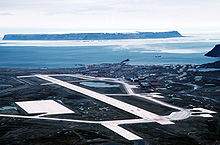Maintaining A Cold Peace.
Monday, July 31, 2023
Written by Alan W. Dowd, ASCF Senior Fellow
Categories: ASCF Articles The Dowd Report

August 2023—The July installment of this series on Arctic security laid the groundwork by offering a thumbnail sketch of what Putin is doing and planning in the High North. This issue discusses how the U.S. and its allies are responding.
An Arctic Nation
First things first: As a 2013 U.S. government report bluntly reminded America’s enemies (and the American people), the United States is “an Arctic nation with broad and fundamental interests in the Arctic.” Too many Americans forget—and our enemies tend to resent—the fact that a large swath of our 49th state lies inside the Arctic Circle; some 27,000 American troops are based in Alaska, and American troops man a key military base above the Arctic Circle (Pituffik Space Base, formerly known as Thule Air Base).
In short, America’s renewed interest in, and commitment to, Arctic security is justified and long overdue.
The past six years have seen the U.S. steadily expand and deepen Arctic-related initiatives.
The Trump administration issued a policy directive on safeguarding U.S. interests in the Arctic and an Arctic defense strategy. In addition, the Trump administration reactivated the 2nd Fleet, which focuses on the North Atlantic and Arctic.
Taking the baton, the Biden administration established a new post in the Pentagon committed to Arctic security—deputy assistant secretary of defense for Arctic and global resilience—and issued a new whole-of-government strategy for the Arctic. The strategy makes clear that the U.S. “seeks an Arctic region that is peaceful, stable, prosperous and cooperative,” while emphasizing that the U.S. “will deter threats to the U.S. homeland and our allies by enhancing the capabilities required to defend our interests in the Arctic.” The strategy notes that Russia’s war on Ukraine has “enhanced unity with our Arctic partners.”
Under President Biden, the Pentagon has redesignated the U.S. Army’s 12,000 troops in Alaska as the 11th Airborne Division. The soldiers in the reconstituted 11th Airborne, Army Chief of Staff Gen. James McConville vows, will be “masters” in “Arctic warfighting, in extreme cold weather, in mountainous and high-altitude terrain.”
Just this year, the 11th Airborne led wargames in Alaska involving 8,000 U.S. personnel. Elements of the 11th Airborne also joined elements of the 10th Mountain and Virginia National Guard for exercises in Finland with the Finnish military. In addition, the Finnish armed forces hosted large-scale ground exercises this spring above the Arctic Circle featuring 7,500 troops from the United States, Britain, Norway, and Sweden.
U.S. troops joined troops from Norway, Britain, and Netherlands in spearheading cold-weather exercises in Norway, which put 20,000 troops in the field. And in its first deployment, the USS Gerald R. Ford sailed into Norway’s Arctic waters.
In May, thousands of U.S. troops, five ships, and more than 150 aircraft—joined by British and Australian assets—linked up in Alaska for Northern Edge 2023. It was “the largest and most complex Northern Edge exercise we’ve ever developed,” according to an American officer.
Finally, it’s worth noting that America’s largest concentration of fifth-generation warplanes (F-22s and F-35s) is now deployed in Alaska—and that the Air Force is investing some $6 billion annually in Arctic capabilities.
Allies
Thankfully, the U.S. isn’t alone in the Arctic. Close allies Canada, Denmark, Iceland, Sweden, Finland, and Norway are Arctic nations. Importantly, all of these nations are current or future members of NATO.
NATO is crucial to leveraging and maximizing the combined capabilities of these Arctic allies. As they learned during the Cold War, America, and its allies can achieve more by pooling their assets, identifying and pursuing common interests, and coordinating plans and deployments than they can by going it alone. NATO’s “Arctic Seven” need to formalize and harmonize their efforts, combine their capabilities, and deal with Moscow from a posture of unity and strength. Any number of bodies or subagencies within the NATO alliance—a center devoted to Arctic issues, an Arctic working group, even an Allied Command Arctic—could enable the U.S. and its Arctic region allies to deal with Moscow from a posture of strength and thus deter further Russian aggression.
What Churchill said of his Russian counterparts is true of Putin and his generals: “There is nothing they admire so much as strength, and there is nothing for which they have less respect than for weakness.” That was true when NATO confronted Moscow in West Berlin and the North Atlantic during Cold War I; that was true when NATO brought stability to, and consolidated free government in, Eastern Europe during the post-Cold War period; and that remains true as NATO confronts Moscow’s new/old threat in the Arctic in these early chapters of Cold War 2.0.











